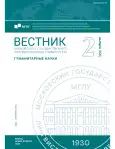Reception in Diachrony: the Genesis of English Legal Terms in Roman Law
- 作者: Muravev Y.А.1
-
隶属关系:
- Peoples’ Friendship University of Russia named after Patrice Lumumba
- 期: 编号 2(896) (2025)
- 页面: 37-43
- 栏目: Linguistics
- URL: https://bakhtiniada.ru/2542-2197/article/view/283958
- ID: 283958
如何引用文章
全文:
详细
This research examines the etymology of a number of terms of the modern legal English language, which have a connection with the institutions of Roman law and ancient Roman religion. The purpose of the study is to establish the features of phonetic, word-formation, lexical, syntactic and semantic derivation of such terms, to identify their deep semantic structure in legal English and to clarify the dominants of their semantic fields. The analysis of the origin of such terms using the methods of contrastive linguistics allows a deeper understanding of the meaning of individual institutions and legal concepts that are still used in modern common law jurisdictions and the Romano-Germanic (continental) legal family.
作者简介
Yury Muravev
Peoples’ Friendship University of Russia named after Patrice Lumumba
编辑信件的主要联系方式.
Email: muravyev_yua@pfur.ru
PhD (Pedagogy), Associate Professor at the Department of theory and practice of foreign languages at the Institute of Foreign Languages,
俄罗斯联邦参考
- Pokrovskii, I. A. (1998). Istoriia rimskogo prava = The history of Roman Law. Saint Petersburg: Letnii sad. (In Russ.)
- Shaid, Dzh. (2006). Religiia rimlian = The religion of the Romans. Moscow: Novoe izdatel’stvo. (In Russ.)
- Noviczkij, I. B. (2014). Rimskoe pravo. Textbook. 3d ed. Moscow: KNORUS. (In Russ.)
- Novitskii, I. B., Pereterskii, I. S. (2012). Rimskoe chastnoe pravo = Roman Private law. Moscow: Zertsalo-M. (In Russ.)
- Kofanov, L. L. (2001). Zhrecheskie kollegii v Rannem Rime = Priestly colleges in Early Rome. Moscow: Nauka. (In Russ.)
- Dozhdev, D. V. (1996). Rimskoe chastnoe pravo pravo = Roman Private law. Moscow: INFRA M – NORMA. (In Russ.)
- Duckworth, M. (1995). Law Words. Sydney: University of Sydney.
- Krois-Lindner, A. (2006). International Legal English. Cambridge: Cambridge University Press.
- Jacobson, R. (1980). The framework of language. Michigan: Michigan Studies in the Humanities.
- Andersen, P. (1997). A Theory of Computer Semiotics. Cambridge: Cambridge University Press.
- Diumezil’, Zh. (2018). Religiia Drevnego Rima = The Religion of Ancient Rome. St.Petersburg: Izdatel’skiĭ proekt "Kvadrivium." (In Russ.)
- Livy, Titus Livius (1989). Ab urbe condita. Braunschweig: Vieweg+Teubner Verlag.
- Harrison, W. (1994). The Description of England: The Classic Contemporary Account of Tudor Social Life. New York: Dover Publications Inc.
- Mommsen, T. (1997). Istoriia Rima = The History of Rome. St.Petersburg: IUVENTA. (In Russ.)
- Galikarnasskii, D. (2005). Rimskie drevnosti = Roman antiquities (vols. 1–3): in 3 vols. Moscow: Rubezhi XXI. (In Russ.)
- Turner, V., Bruner, E. M. (1986). The Anthropology of Experience. Urbana and Chicago: University of Illinois Press.
- Eliade, M. (1995). Aspekty mifa = Aspects of the myth. Moscow: Invest-PPP. (In Russ.)
- Van Gennep, A. (1999). Obriady perekhoda = Rites of Passage. Moscow: Vostochnaja literatura RAN. (In Russ.)
- Plessis, P. (2006). Janus in the Roman Law of Urban Lease. Historia: Zeitschrift für Alte Geschichte, 55, 48–63.
- Gak, V. G. (1989). O kontrastivnoi lingvistike. Kontrastivnaia lingvistika = On contrastive linguistics. In Neroznak, V. P., Gak, V. G. Contrastive linguistics (vol. XXV, pp. 5–17). (In Russ.)
- Brinton, L. (2000). The structure of modern English: a linguistic introduction. Amsterdam: John Benjamins Publishing
- Company.
补充文件










